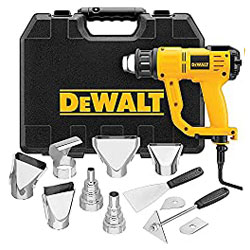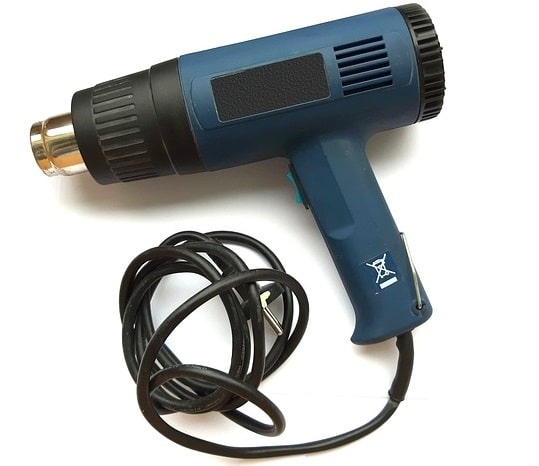Best Heat Guns in 2024 — Buyers Guide, Review and Comparison
These handheld machines deliver a focused plume of hot air onto your working material, allowing you to complete projects such as stripping paint, softening caulk, vinyl wrapping cars, and thawing pipes. And — unlike blowtorches — they’re completely flame free, thus increasing their safety.
Heat Gun Product Comparison Table
| IMAGE | PRODUCT | DETAILS | ||
|---|---|---|---|---|
|
Best Digital 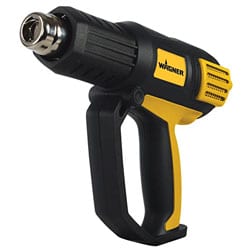
|
Best Digital
|
Wagner HT4500
|
Features
|
Check Price at Amazon Wagner HT4500 Review Wagner HT4500 Review |
|
Best Automotive 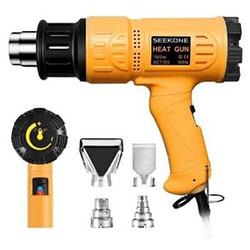
|
Best Automotive
|
SEEKONE SDL2816
|
Features
|
Check Price at Amazon SEEKONE SDL2816 Review SEEKONE SDL2816 Review |
|
Best Electronics 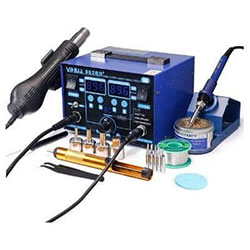
|
Best Electronics
|
YIHUA 862BD
|
Features
|
Check Price at Amazon YIHUA 862BD Review YIHUA 862BD Review |
|
Best Wagner 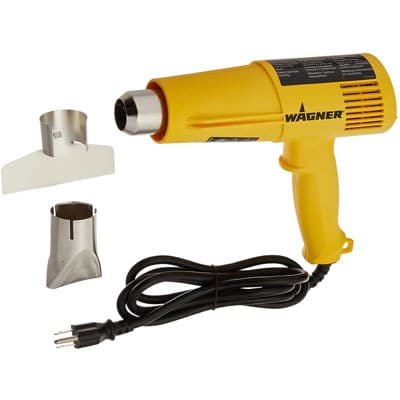
|
Best Wagner
|
Wagner HT3500
|
Features
|
Check Price at Amazon Wagner HT3500 Review Wagner HT3500 Review |
|
Best Embossing 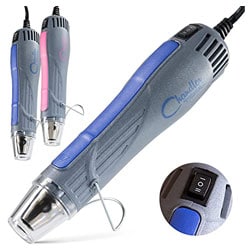
|
Best Embossing
|
Chandler Tool Embossing Heat Gun
|
Features
|
Check Price at Amazon Chandler CTHG150D Review Chandler CTHG150D Review |
|
Best Mini 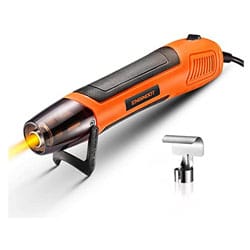
|
Best Mini
|
Engindot HGP35AC
|
Features
|
Check Price at Amazon Engindot HGP35AC Review Engindot HGP35AC Review |
|
Best Dual Temperature 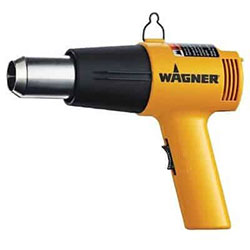
|
Best Dual Temperature
|
Wagner HT1000
|
Features
|
Check Price at Amazon Wagner HT1000 Review Wagner HT1000 Review |
|
Best Cordless 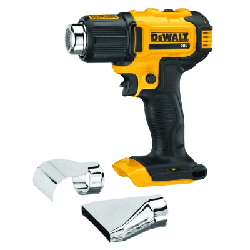
|
Best Cordless
|
DeWalt DCE530B
|
Features
|
Check Price at Amazon DeWalt DCE530B Review DeWalt DCE530B Review |
Heat Gun Buying Guide
Sure, your drill will make holes and your nail gun will shoot tacks — but to be fair to these stalwarts of DIY armory — they can’t do much else.
Hot air guns are different.
These power tool polymaths are so incredibly versatile, they should be considered as essential in the home as a dishwasher or cooking range. In fact — the scope of their applications is so vast, I had to write a Heat Gun Uses article, simply to touch the surface of the jobs they can tackle.
Paint stripping, pipe thawing, plastic molding, component desoldering, rusted bolt removing, window tinting — if the project requires heat — a hot air gun will cope. Darn, they can probably even raise your kids and satisfy you in the bedroom (don’t try it).
Perhaps the only heat-related DIY application they struggle with is welding — they don’t reach sufficiently high temperatures to melt and soften metal. So, if that’s what you’re looking for, choose a blowtorch or TIG machine instead. However, for any jobs requiring up to 1300 degrees Fahrenheit of power — a hot air gun is perfectly suitable.
When selecting your ideal heat gun tool, consider:
Corded or cordless.
Heat Gun Tools Categories Comparison
Digital Heat Gun
- LCD control console.
- Push-button heat selection.
- Large temperature range — typically 150-1100 degrees Fahrenheit.
Automotive Heat Gun
- Easy to operate temperature control for gloved or oily hands.
- Long power cords.
- Additional nozzles for optimum heat delivery.
Electronics Heat Gun
- Temperature range of around 212 to 896 degrees Fahrenheit.
- Concentrator nozzles to focus heat.
- Highly controllable airflow settings.
Paint Removal Heat Gun
- More than one temperature setting.
- Comfortable for long projects.
- Don’t require additional nozzles.
Embossing Heat Gun
Embossing heat guns allow you to add a professional and eye-catching finish to your
handicraft projects — delivering the optimum amount of both air temperature and
blower intensity. This enables you to mold and melt embossing powder without
scorching or burning the underlying card or paper. Usually lightweight, these guns make
one-handed use straightforward.
- Rapid heat up.
- Relatively low temperatures for the heat gun category.
- Typically single or dual heat settings.
Mini Heat Gun
- Typically used in a pencil grip.
- Lower wattage than standard-sized models.
- Incorporate a nozzle protector for safety.
Dual Temperature
- Twin temperatures..
- Simple operation.
- Rocker switch heat selection.
Wagner Heat Guns
- Impressive warranties.
- USA-based company.
- Favored by professionals.
DeWalt Heat Guns
- Founded in the USA in 1923.
- Impressive service center network.
- Industry-leading technology.
Cordless Heat Guns
Although relatively rare in the heat gun arena — due to the high-energy demands placed on their lithium-ion cells — cordless heat guns free you from the shackles of mains cabling. Typically running at around 900 degrees Fahrenheit, they lack the mighty heat delivery of corded units, yet still deliver sufficient grunt to strip paint and remove varnish. A standard charge provides, on average, 40 minutes of use from a full cell.
- Highly portable.
- Can be operated away from electrical power sources.
- No risk of tripping over cables.
What Is a Heat Gun?
Essentially, a hot air gun is a similar shape to a power drill, and usually wielded in the same pistol-grip position. The head casing contains two crucial components — a heating coil and a fan.
When connected to a power source, the ceramic coil heats up, while the fan blows over this component — leading to your gun emitting an intense hot stream of air.
You then direct this heat plume onto your working material, often combined with an interchangeable nozzle accessory to customize heat delivery.
Heat Gun Safety
My advice is this:
It’s a ‘gun’ — so treat it as the same as you would a firearm. Don’t point it at anyone, keep it unloaded when not in use (i.e. not switched on), and don’t store it in the waistband of your pants.
The top rated heat guns listed above typically boast safety features not found on the more budget units. These can include:
- Cord protector — preventing the mains cable from being pulled free from the gun.
- Side fins — allowing you to lay the gun on its side while still powered on, a characteristic of the Wagner Furno 300.
- Overload preventer— ensuring the internal components don’t become too hot, protecting your delicate hands and the crucial heating coil, seen on the SEEKONE machine.
- Hands-free capability — meaning you don’t even think about holding the hot air machine in your mouth.
- Nozzle protectors — often found on crafting guns, such as the Chandler unit, that ensures your fingers don’t touch the hot tip.
However, with a hot air machine, there’s no visible fire. This can lead to a blasé attitude — despite the unit knocking out over 1300 degrees Fahrenheit.
So, be careful.
Here are my top tips on using a heat gun in a safe and responsible manner:
- If using an extension cable, check the amp rating is suitable for your tool.
- Don’t use your hot air machine on or near flammable materials.
- Unless your unit incorporates safety sidebars, always turn it off before laying it down on your workbench.
- Ensure your heat gun has completely cooled before storage.
- Don’t touch the nozzle with your fingers or clothing.
- Never look down the end of the heat gun while it’s switched on.
- Always direct the heat plume away from your body.
- Never put anything down the nozzle of your machine.
- Don’t use the hot air unit in the rain.
- Always wear protective equipment such as eye goggles and gloves.
- Never attempt to repair the heat gun yourself.
- Avoid blocking the ventilation holes of the heat tool.
- Ensure the heat gun type is suitable for the working material.
- Always keep your machine at least one centimeter away from your project.
- Avoid wearing loose-fitting clothing while using your heat gun, to prevent accidental burns and scorches.
Considerations When Choosing a Heat Gun
Naturally, reading heat gun reviews is important — but ensure that the unit in question is relevant to the job in hand. It’s akin to buying a smartphone because it has high user ratings — and then being disappointed when it won’t cook your dinner.
Here’s what you should think about.
Temperature Range
Generally speaking, the temperature capabilities of the unit determines its spectrum of applications.
For example, here are the heat requirements for a few of the most common heat gun uses (in Fahrenheit):
- 180-220 degrees — window tinting.
- 200-300 degrees — vinyl wrapping.
- 250-300 degrees — heat activating glue.
- 250-500 degrees — desoldering (depending on tin/lead ratio)
- 300-500 degrees — removing decals.
- 325-425 degrees — vinyl siding.
- 330-430 degrees — molding plastic.
- 350-400 degrees — cable sheath shrinking.
- 400-700 degrees — drying paint.
- 450-725 degrees — welding plastic.
- 500-700 degrees — repairing leather.
- 500-800 degrees — shrink wrapping.
- 700-750 degrees — thawing pipes.
- 700-1100 degrees — paint and varnish stripping.
- 1000-1300 degrees — loosening rusted bolts.
Hence, if your hot air plans don’t include anything more than paint removal, you only need a gun with a heat spectrum of 700-1100 degrees. Or — should you be interested in the more niche application of repairing circuit boards — you require an electronics machine with lower temperatures, such as our best rated heat gun for PCBs, the YIHUA 862BD.
However, some heat gun requirements are a little more complicated.
Automotive hot air machines are an excellent example. If you’re a complete gearhead and love nothing more than tinkering with your motor — then a heat gun is crucial. It will help you to tint windows, vinyl wrap your vehicle, loosen brakes, sheath wires, remove decals, and strip bodywork paint.
Yet, this vast array of uses demands a wide spectrum of heat settings. So, in this circumstance, you need a unit that can deliver a temperature range from 180 degrees (for window film) through to 1000 degrees Fahrenheit (for paint removal). Hence, my best value heat gun for motor vehicles, the SEEKONE SDL2816, is my top pick with its 122-1202 degrees Fahrenheit spectrum.
Finally, you may not have one particular project in mind — you’re chasing a unit that can do it all.
That being the case, then you need the ultimate in hot air technology, a digital DIY heat gun.
These incredibly versatile power tools, with an LCD screen, deliver a massive range of heat settings adjustable in relatively small increments. The consummate unit, the Wagner HT4500, offers a 120-1200 degrees Fahrenheit spectrum which you can select in 20-degree steps.
Bear in mind that, as the number of heat levels and spectrum increases, the heat gun prices also rise.

Manufacturer
Usually, I’m not a great advocate of labels and brands. Take one look at photos of me on social media and you’ll see what I mean — my fashion tastes extend to basic work pants and Buffalo check shirts.
But, for hot air power tools, choosing the correct manufacturer can be a worthy consideration.
In this sphere, there are two main ‘big boys’ — Wagner and DeWalt. The heat guns reviews about their products are consistently packed full of praise for their reliability and durability.
Listen up.
They’re not suitable for everyone. If you think that you’ll only be using your hot air machine intermittently — and for short periods at a time — they could be considered an over-indulgence. While still affordable — there are much more budget-friendly yet impressive heat guns on the market — such as the excellent accessory-packed Tacklife HGP72AC.
However, if you’re a professional tradesperson or committed DIYer — look to DeWalt and Wagner.
Quality wise, there’s little to separate these two industry behemoths. Both of them offer:
- Excellent post-purchase customer service.
- Impressive warranties.
- Category-beating reliability.
- A wide availability of spare parts.
- Years of power-tool experience.
- Headquarters in the USA.
The difference occurs in the range of products available. Wagner, as a paint application and removal specialist, offers the whole gamut of hot air machines. These range from the simple-to-use dual temperature HT3500 — through to my ultimate heat gun of all time — the digital HT4500.
DeWalt, however, only offers the most technologically advanced heat tools and a restricted line — including the almost unique cordless DCE530B and the digital D26960K.
Should you want to know where to buy heat guns from one of these major players — I’ve put together both a Wagner top list and a DeWalt product rundown to make finding your ideal machine effortless.
Additional Applications
The more substantial heat guns may have the temperature capability to cope with any project you can throw at them — but that doesn’t mean they’re going to be the most user friendly.
For example, heat guns are excellent tools for the committed hobbyist. If you’re into crafting, you may have a requirement for glue activation, powder embossing, and clay softening.
Typically, these applications demand a much higher degree of precision and accuracy than stripping a door — and there are specialized units designed specifically for art applications.
A machine such as this, sometimes referred to as a micro heat gun, possesses the typical features of:
- Being lightweight.
- Held in a pencil grip.
- Delivering a narrow plume of heat.
- Boasting less intense fan speeds.
- Including a nozzle protector.
Bear in mind that — since they are crafting-focused — they are limited for other applications. This is because they don’t deliver sufficiently high temperatures to tackle anything other than low heat artwork.
But, if that’s your bag, and you’re thinking — where can I buy a heat gun for my hobbies? Take a look at my best embossing gun reviews.
Corded or Cordless
If you’ve been wondering where to get a heat gun without a mains lead — you’re not alone — they’re incredibly elusive.
The truth is, a few years ago, owning a cordless heat gun was purely a dream of the keen DIYer. Manufacturers struggled to find a way to produce sufficient and long-lasting heat from a power cell — an issue which I explore thoroughly in my Cordless Heat Guns article.
However, a few dedicated brands took up the challenge — meaning that being cable-free is no longer a pure aspiration — it’s now reality. That said, there are only a handful of these freedom-boosting guns on the market — crowned by the impressive DeWalt DCE530B.
Being released from AC power enables you to work in areas away from electrical outlets. It increases safety too — removing the tripping or tangling hazards of a mains cord. The downside is that your working time is restricted to around 40 minutes per lithium-ion cell. This means that, for longer projects, you either have to frequently recharge or have additional battery packs on hand.
Reduces Fatigue
Despite heat guns being excellent time savers, some projects remain inherently time intensive.
A few paint removal jobs — such as stripping baseboards or banisters — will require wielding your hot air gun for an extended period. This could cause fatigue and aches on your hands. It also means you may need to take frequent breaks to recharge your wrist stamina — making the project last even longer.
Furthermore, those with medical issues, or being of advanced years, may find holding a unit heavier than two pounds to be impossible.
Should this apply, I’d recommend looking at a lightweight machine, such as the dual temperature HT1000. This particular unit comes in at just 1.46 pounds — making it pleasingly easy on the hand muscles. Alternatively, opt for a heat gun like the Wagner HT4500, which offers two-handed operation — reducing the stress on your dominant hand.

Size and Weight
Having a massive tool isn’t always beneficial.
While having a large heat gun in your hands may provide a satisfyingly tactile experience — it can also be an encumbrance in your DIY projects.
Admittedly, a big heat gun will generally offer higher temperatures than its smaller counterparts, as it can house a more substantial coil and fan. However some units — such as the Black and Decker HG1300 — offer a more compact construction than a standard unit — yet still deliver 1000 degrees Fahrenheit of power.
Yet, sometimes, small is indeed beautiful. The advantages of a less hefty power tool include:
Accessibility
Should you want to work in confined areas — such as loosening stubborn hardware beneath sinks, or wire sheathing in an engine bay — a standard-sized unit may prove cumbersome.
Some guns, such as the snub-nosed Milwaukee 2688-20, allow you to access these limited spaces without injuring your precious knuckles.
If you’re wondering — where can I get a heat gun with these smaller characteristics? — check out my mini heat gun rundown.
Conclusion
The staples of every toolbox are a hammer and a screwdriver — and if I was to add a power tool to the essential equipment category — I would include a hot air gun.
It has the ability to strip paint, thaw pipes, soften putty, wrap cars, weld plastic, and 101 other applications. Once you own a heat gun, you’ll wonder how you managed to survive without one.
When making a purchase, first and foremost, consider what you’re going to use it for. Many users will find a basic dual temperature unit more than adequate — being able to cope with such projects as paint removal, shrink wrapping, and varnish stripping.
However, if you’re a committed DIY fanatic, you may find the vast temperature range of the digital units more attractive — increasing your project versatility and enabling you to tint windows, desolder, and remove decals.
And, if you have a particular niche requirement — such as crafting or PCB repair — look toward the embossing and electronics hot air categories.
The bottom line.
If you’re looking to expand your DIY résumé — check out the heat guns above — undoubtedly the hottest power tools on the market.
Heat Gun Frequently Asked Questions
Q: Can I Buy Heat Gun Accessories?
Yes. Many manufacturers produce and retail additional nozzles that allow you to tailor the heat delivery intensity to suit your particular project. Alternatively, you can buy a complete heat gun kit, such as the Wagner HT4500, which comes with a carry case, paint scraper, and four nozzles.
Q: Where to Buy a Heat Gun?
Many of the larger hot air gun brands don’t retail directly from their official sites — meaning you have to seek out third-party retailers. But, there’s no need to do a ‘heat gun near me’ search on Google — I’ve done it for you! You can purchase all of my top picks from Amazon — including the ultimate machine, the Wagner HT4500.
Q: What Do You Use a Heat Gun For?
A high-quality multi-purpose heat gun that offers a choice of operating temperatures can strip paint, dry damp wood, remove adhesives, thaw frozen pipes, weld plastic, defrost freezers, and shrink-wrap packaging.
Q: What Is the Best Heat Gun?
In the eyes of many industry experts and judging by its heat gun ratings — the pinnacle of hot air tools is the Wagner HT4500. This impressive machine has LCD control, a temperature range of 120-1200 degrees Fahrenheit, five fan speeds, and comes complete with a carry case and four additional nozzles.
Q: Is an Embossing Gun the Same as a Heat Gun?
Yes. Embossing guns are particularly niche types of hot air machines that are ideal for crafting. However, their small nozzles and relatively low-temperature ranges make them unsuitable for most hardcore DIY projects.
Q: Can Heat Guns Strip Paint From Wood?
Of course! Hot air machines are the perfect tool for removing paint from wood — being less time intensive than sanding, and safer than using chemical strippers. To check out how to complete this project — take a look at my How to Remove Paint from Wood guide.
Q: Is a Heat Gun Dangerous?
Heat guns are no more dangerous than other power tools, such as drills or sanders — but they should still be treated with respect. While they don’t have an exposed flame like a blowtorch, they can deliver temperatures in excess of 1000 degrees Fahrenheit.
Therefore, care must be taken during use. Always wear protective equipment, never leave your machine unattended while switched on, and never use near flammable materials, such as gasoline or oil.


